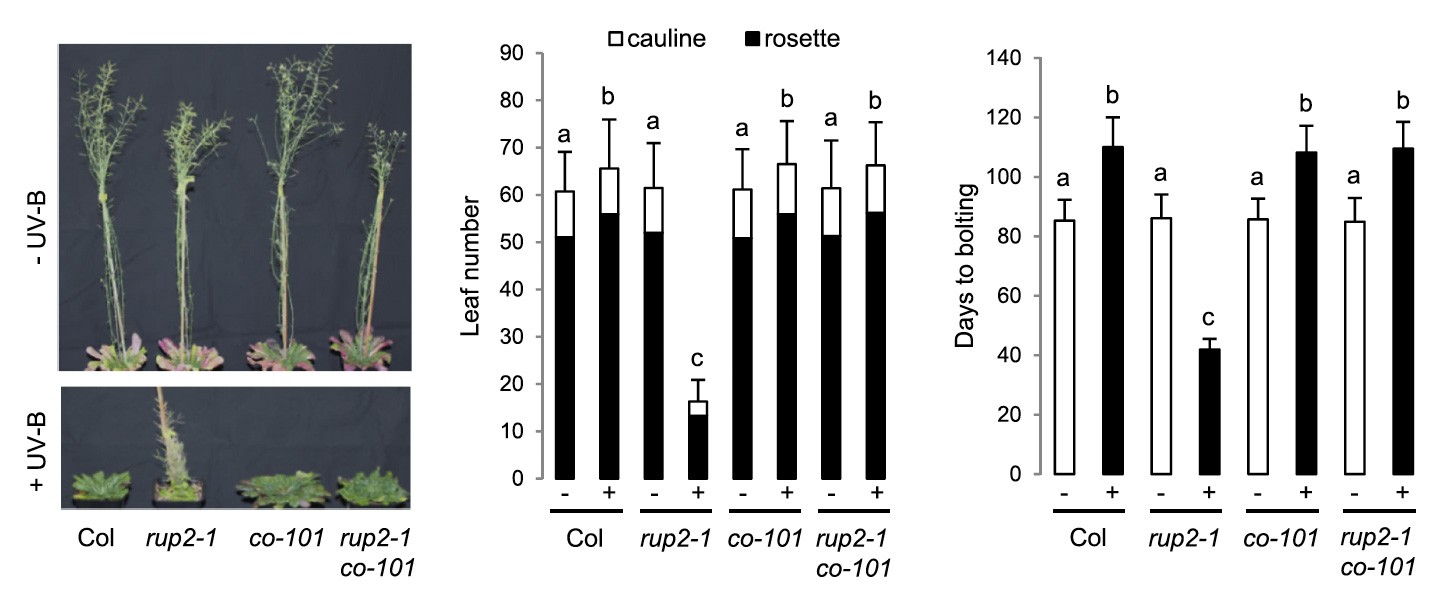博文
Genes & Development:非诱导型光周期下拟南芥开花的分子调控机制
||
Arabidopsis RUP2 represses UVR8-mediated flowering in noninductive photoperiods
First author: Adriana B. Arongaus; Affiliations: University of Geneva (日内瓦大学): Geneva, Switzerland
Corresponding author: Roman Ulm
Plants have evolved complex photoreceptor-controlled mechanisms to sense and respond to seasonal changes in day length. This ability allows plants to optimally time the transition from vegetative growth to flowering. UV-B is an important part intrinsic (固有的) to sunlight; however, whether and how it affects photoperiodic flowering (光周期开花) has remained elusive. Here, we report that, in the presence of UV-B, genetic mutation of REPRESSOR OF UV-B PHOTOMORPHOGENESIS 2 (RUP2) renders (使成为) the facultative (兼性的) long day plant Arabidopsis thaliana a day-neutral plant (日中性植物) and that this phenotype is dependent on the UV RESISTANCE LOCUS 8 (UVR8) UV-B photoreceptor. We provide evidence that the floral repression activity of RUP2 involves direct interaction with CONSTANS, repression of this key activator of flowering, and suppression of FLOWERING LOCUS T transcription. RUP2 therefore functions as an essential repressor of UVR8-mediated induction of flowering under noninductive short day conditions and thus provides a crucial mechanism of photoperiodic flowering control.
植物演化出了复杂的光感受控制机制来感知和响应于季节变化中的日长改变。这种特性使得植物能够在适当的时间进行营养生长向生殖生长的转变。UV-B是太阳光中重要的组成部分,然而其是否及如何影响植物的光周期开花还不清楚。本文的研究显示在UV-B存在的情况下,RUP2基因的遗传突变能够使得兼性长日照植物拟南芥成为日中性植物,并且该表型依赖于UV-B感受器UVR8。进一步的研究显示RUP2的开花抑制活性与其和CONSTANS的互作相关,RUP2能够抑制开花关键激活子CONSTANS的表达,同时也能够抑制FLT基因的转录。因此,RUP2作为短日照条件下由UVR8介导的开花诱导的抑制子,在光周期开花调控中发挥重要作用。
通讯:Roman Ulm(http://www.unige.ch/sciences/biologie/bioveg/ulm/pages/RomanU.htm)
�
�研究方向:植物的UV-B感知和由UVR8介导的信号转导;MAP激酶磷酸酶与环境胁迫信号。
doi: 10.1101/gad.318592.118
Journal: Genes & Development
Published date: 01 October, 2018
(P.S. 原文下载:链接:https://pan.baidu.com/s/1qFiSsqwlF_7JjmGMbedfhQ 密码:dmu6)
https://blog.sciencenet.cn/blog-3158122-1140874.html
上一篇:Trends in Plant Science:ROS精细调控植物干细胞命运
下一篇:New Phytologist:植物紫外辐射受体UVR8介导的信号转导
全部作者的其他最新博文
- • Plant Physiology:CsMADS3促进柑果中的叶绿素降解和类胡萝卜素合成(华中农业大学)
- • Molecular Plant:LBD11-ROS反馈调节作用于拟南芥的维管形成层增殖和次生生长(浦项科技大学)
- • Science Advances:根结线虫通过调控植物的CLE3-CLV1模块,促进侵染进程(日本熊本大学)
- • Nature Communications:油菜素内酯参与植物营养生长期转变的分子机制解析(浙江农林大学)
- • Current Biology:光合作用产生的蔗糖驱动侧根“生物钟”(德国弗莱堡大学)
- • PNAS:花同源异型基因在叶中被抑制、花中被激活的分子机制(南卡罗来纳大学)


